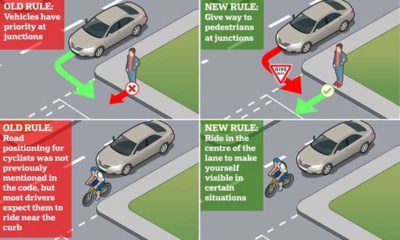Road priorities in the Highway Code change on 29th January
The Highway Code has eight new rules and major updates to 49 existing ones with effect from 29th January 2022. The biggest single change, and one well worth getting on top of now, is who has priority. Others to revise include Overtaking, Roundabouts & Dutch Reach.
Priorities

The new rules include a ‘Hierarchy of Road Users’ which gives priority to the most vulnerable road users such as pedestrians, cyclists & equestrians. The most significant new rules are:
Rule H1
Those in charge of vehicles that can cause the greatest harm in the event of a collision bear the greatest responsibility to take care and reduce the danger they pose to others.
So, we have in order of responsibility:
- Large vehicles such as HGVs, buses & coaches,
- Vans & minibuses,
- Cars & taxis,
- Motorcyclists,
- Horse riders,
- Cyclists, &
- Pedestrians.
Rule H2
At a junction you should give way to pedestrians crossing or waiting to cross a road into which or from which you are turning.
This is directly opposed to the current situation where the road vehicles assume they have priority to use the road unless a crossing is in place – essentially this means that every junction has become a crossing point.
Rule H3
You should not cut across cyclists, horse riders or horse drawn vehicles going ahead when you are turning into or out of a junction or changing direction or lane.
This furthers the position in H2, with more vulnerable road users having greater priority to access the road not only at junctions, but when changing lanes.
Is it enforceable?
These changes are not reflected in changes to the law and are advisory…
BUT
… the Highway Code can be used in court to establish liability in the event of an accident under the Road Traffic Act. This includes rules which say ‘should/should not or do/do not.’ If you are found to be at fault in an accident as a result of not complying with the Highway Code, you may face charges in court.
Other Significant Changes
Overtaking
Rules on overtaking now clarify how much clearance you should give:
Give motorcyclists, cyclists, horse riders and horse drawn vehicles at least as much room as you would when overtaking a car (see Rules 211 to 215). As a guide:
- leave a minimum distance of 1.5 metres at speeds under 30 mph
- leave a minimum distance of 2.0 metres at speeds over 30 mph
- for a large vehicle, leave a minimum distance of 2.0 metres in all conditions
- pass horse riders and horse-drawn vehicles at speeds under 15 mph and allow at least 2.0 metres space
- allow at least 2.0 metres space where a pedestrian is walking in the road (e.g. where there is no pavement) and you should pass them at low speed
- you should wait behind the motorcyclist, cyclist, horse rider, horse drawn vehicle or pedestrian and not overtake if it is unsafe or not possible to meet these clearances
- take extra care and give more space when overtaking motorcyclists, cyclists, horse riders, horse drawn vehicles and pedestrians in bad weather (including high winds) and at night.
… also on overtaking:
When you see a horse on a road, always slow down to a maximum of 15 mph. Be patient, don’t sound your horn or rev your engine. When safe to do so, pass wide and slow, allowing at least 2.0 metres space.
Remember there are three brains at work when you pass a horse; the rider’s, the driver’s and the horse’s. Don’t forget horses are flight animals and can move incredibly quickly if startled.
Roundabouts
Quite a change at roundabouts as well:
You should give priority to cyclists on the roundabout. They will be travelling more slowly than motorised traffic. Give them plenty of room and do not attempt to overtake them within their lane. Allow them to move across your path as they travel around the roundabout.
Cyclists, horse riders and horse drawn vehicles may stay in the left-hand lane when they intend to continue across or around the roundabout. Drivers should take extra care when entering a roundabout to ensure that they do not cut across cyclists, horse riders or horse drawn vehicles in the left-hand lane, who are continuing around the roundabout.
Dutch Reach
This advises that road users should open the door of their vehicle with the hand on the opposite side to the door they are opening which naturally causes the person to twist their body making it easy to look over their shoulder and check for other road users:
You should open the door using your hand on the opposite side to the door you are opening, e.g. use your left hand to open a door on your right-hand side. This will make you turn your head to look over your shoulder. You are then more likely to avoid causing injury to cyclists or motorcyclists passing you on the road, or to people on the pavement
You can find out more on the GOV.UK Website.

